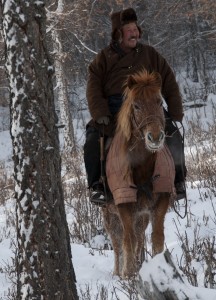No products in the cart.
What the Horses do in Winter
What the horses do in winter is what many of our riding guests wonder and ask us about.
 The winters are pretty harsh in Mongolia. Hard to believe, but the country doesn’t really get that much snow. When there are storms, they can be brutal though, especially on the open steppe or grasslands that Mongolia is famous for, turning what little snow there is on the ground into a hard windblown frozen crust difficult to break through. Temperatures can drop to -40c or more for days at a time. Unlike other livestock, like cows, goats and sheep, horses are mostly left to fend for themselves during winter. It’s up to them and their skill in pawing through hard crust snow to find enough grass to eat and survive the long bitterly cold months from December through March and to avoid predators…wolves. Then they’ve got to make it through the howling spring storms of April, which can be the most lethal to animals already undernourished and weak from cold. It’s this feast and famine throughout the year that makes the Mongolian horse the tough creature that it is. With the green grass of spring, skin and bones are transformed into sleek energetic steeds in a matter of a couple of weeks. Every year it’s a miracle of nature to watch and a point of admiration for these tough horses.
The winters are pretty harsh in Mongolia. Hard to believe, but the country doesn’t really get that much snow. When there are storms, they can be brutal though, especially on the open steppe or grasslands that Mongolia is famous for, turning what little snow there is on the ground into a hard windblown frozen crust difficult to break through. Temperatures can drop to -40c or more for days at a time. Unlike other livestock, like cows, goats and sheep, horses are mostly left to fend for themselves during winter. It’s up to them and their skill in pawing through hard crust snow to find enough grass to eat and survive the long bitterly cold months from December through March and to avoid predators…wolves. Then they’ve got to make it through the howling spring storms of April, which can be the most lethal to animals already undernourished and weak from cold. It’s this feast and famine throughout the year that makes the Mongolian horse the tough creature that it is. With the green grass of spring, skin and bones are transformed into sleek energetic steeds in a matter of a couple of weeks. Every year it’s a miracle of nature to watch and a point of admiration for these tough horses.
Most herders will keep a couple of their favorite horse’s close and winter fed, to be used throughout the year for herding their other livestock and for transport. These horses are well taken care of and vital to the herder’s life. The herder we work with, Yadmaa, is no different as he keeps a watchful eye on the horse herd and the other animals.
Our Expedition Horses
Our horses are fortunate in this sense. Although they all know well this cycle of winter and summer, we keep the horses we own and use for Stone Horse expeditions fed and in the best condition possible without pampering them. Like all Mongolian horses, they’ve never spent a night in a barn. But, ours get daily rations of hay and oats throughout the winter to keep them fit and supplement their daily foraging for grass beneath the winter’s snow. During the day they roam free as a herd around the Darkhid Valley area looking for the best places to find grass and water, pawing through snow and breaking thick ice in small rivers with their hooves for a drink. They also eat a considerable amount of snow to quench their winter thirst. On the open steppe where there may be very few winter water sources, eating snow is their only option. But Mongolian horses have long adapted to this way of life.
Our herd spends their day moving about the valley, through forest, up on to the ridge tops in search of grazing. It’s not uncommon that they would see wolves in their daily travel. At least we do see wolf tracks bearing witness to this. But no wolf in its right mind will attack a group of healthy strong horses with much success. They prefer to isolate a single animal found far away from the herd. Over the years, we have lost a couple of horses to wolves, but the herd is ever alert to this danger, and that’s clear from their behavior.
As the winter sun begins to set, the horses slowly make their way back from the daily wandering to a corral area where the hay is kept and with great expectations for their nighttime feed. The next morning the routine begins again.
[nggallery id=23]

